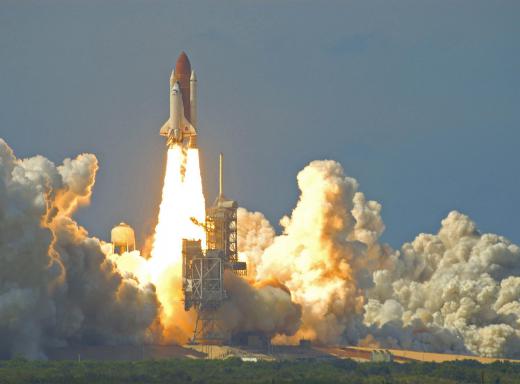How does a Ballistic Missile Work?
 Michael Anissimov
Michael Anissimov
A ballistic missile is a type of large and powerful missile designed to deliver a warhead across large distances to a predetermined target. Ballistic missiles follow suborbital trajectories, reaching space (100 km+) altitudes and exiting the Earth’s atmosphere, in some cases traveling as high as 1,200 km over the surface for intercontinental ballistic missiles. Such missiles are called “ballistic” because after an initial boost phase, the rest of the course is usually determined by ballistics. A smooth parabolic line.
Ballistic missiles come in many shapes and sizes. In the United States, ballistic missiles are divided into four range classes:
- intercontinental ballistic missile (ICBM) – over 5500 kilometers
- intermediate-range ballistic missile (IRBM) – 3000 to 5500 kilometers
- medium-range ballistic missile (MRBM) 1000 to 3000 kilometers
- short-range ballistic missile (SRBM) up to 1000 kilometers

For ranges less than 350 km, the ballistic missile never leaves the Earth’s atmosphere. Note that the only three ballistic missiles ever actually used in battle were only in the short-range category, and contained conventional explosives. Most ballistic missiles in existence today are meant to carry nuclear warheads, though none of these have been used in war yet.

Ballistic missiles use either a solid or liquid fuel. The older missiles, such as the V2 rocket used by Nazi Germany during WWII and the first ballistic missiles built by the US all used liquid fuel. In many cases, the fuel in a liquid propellant ballistic missile is liquid hydrogen whereas the oxidizer is liquid oxygen. The two must be kept at cryogenic temperatures or they revert to a gas phase. During launch, the two gases are rapidly pumped out of storage chambers in the presence of a spark, which ignites the mixture and propels the rocket forward. The byproduct of the burning fuel is water vapor.
The liquid phases of these hydrogen and oxygen are desirable for rocketry because of their improved energy density over the gas phase. Another upside is that liquid-propelled ballistic missiles can have their engines throttled, turned off, or restarted as desired. A downside is that storage of such missiles is a hassle, as the fuel requires constant refrigeration to be ready for launch.
Another variety of liquid propellant are hypergolic propellants. Hypergolic propellants ignite on contact, requiring no ignition source. This is useful for frequent starting and restarting for space maneuvering applications. The most popular version uses monomethyl hydrazine (MMH) for the fuel and nitrogen tetroxide (N2O4) for the oxidizer.
More modern ballistic missiles use solid fuels, as they are easier to store and maintain. The Space Shuttle, for instance, uses two reusable solid boosters, each filled with 1.1 million pounds (453,600 kg) of propellant. The fuel used in powdered aluminum (16%), with iron powder (0.07%) as a catalyst, and ammonium perchlorate (70%) as the oxidizer.
Most ballistic missiles are designed to reach their target in between 15 and about 30 minutes, even if the target is on the other side of the world. Because they are so essential for national security, they are among the most carefully built machines on the planet.
AS FEATURED ON:
AS FEATURED ON:












Discussion Comments
How does it get anywhere in less then a hour or 30 minutes, and wouldn't it be faster to fire the missile straight there?
What if a missile is legal today? how are they tested? Like where they're on a remote island or something? Because mainly every island is inhabited by some kind of life, so where and how are they tested?
@ Anon15428 & Georgesplane- There are currently no land locked countries with intercontinental ballistic missile capabilities. The only countries that have functioning land based ICBMs are the United States, Russia, And China; all countries with extensive coastlines.
A few other countries have submarine launched intercontinental ballistic missile capabilities. These countries are the three that have land based capabilities as well as Great Britain and France. The United States and Russia also have long-range bombers that can deliver nuclear warheads to anywhere in the world.
There are a few countries looking to test ICBM's, joining the elite five. India tested ICBMs in 2009 and Pakistan and North Korea have had unsuccessful tests. It is thought that Israel and Iran are attempting to acquire or develop long range ICBMs.
You should note that some other nuclear powers have nuclear delivery systems, but they are not classified as ICBMs (capable of traveling 5500 kilometers or more).
@ Anon15428- Intercontinental Ballistic Missiles are test launched from facilities built to deal with the launch of these weapon delivery systems. I am not sure if a land locked country would have to launch near the ocean, but The United States does. The U.S. launches ICBM test rockets from Vandenberg Air Force Base in San Luis Obispo California (Potentially other sites, but I am not sure where).
The missiles travel great distances and are often aimed at distant and isolated atolls in the middle of the Pacific Ocean. Testing at sites near the ocean are the safest options since it is somewhat common for ICBMs to fail during one of their ignition stages. I hope this helps.
How do the countries that own these missile actually test them? Suppose a small land-locked country wants to test its long range missile, does it need to test it in the ocean or it can be done through some alternative tests and modify the results?
Post your comments